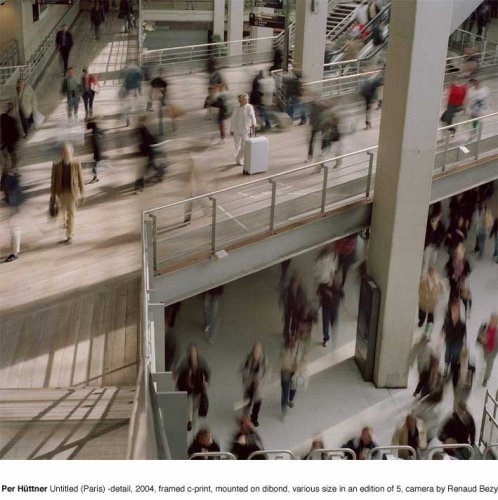Per Huttner
dal 14/1/2005 al 19/2/2005
Segnalato da
14/1/2005
Per Huttner
Galleri Skarstedt, Stockolm
The artist presents a new body of photographic work that focuses on the changes that the world is undergoing since the events of September 11. The images show the artist dressed in his trademark white clothing. His appearance along with the use of a few select objects constitute a shift in the context that change the meaning of a seemingly mundane setting to become one of lurking threats. The pictures are shot in busy urban settings and they raise questions about the relationship between documentary and staged photographs.

Solo exhibition
Skarstedt's is proud to present Per Hüttner's first
solo exhibition at the gallery and his first solo
exhibition of new work in Stockholm since 1999.
Hüttner presents a new body of photographic work that
focuses on the changes that the world is undergoing
since the events of September eleven 2001. In keeping
with his earlier work the images show the barefoot
artist dressed in his trademark white clothing. Using
a panoramic format the pictures are shot in busy urban
settings around the globe such as shopping centres and
train stations. They raise questions about the
relationship between documentary and staged
photographs. The artist himself becomes an indexal
figure. His appearance along with the use of a few
select objects (a suitcase, large sticks or flowers,
candles and framed portraits), constitute a subtle
shift in the context that totally change the meaning
of a seemingly mundane setting to become one of
lurking threats.
These strong and poetic images depict everyday life
where consumerism is pivotal, but looming under the
shadow of fear, grief and where human vulnerability is
laid bare. Death and pain is always present, but not
always in its physical form. They also become a
metaphor for profound life changes and representing
the possibility for hope, transformations and
developments.
With this new work it becomes natural to make
allusions to the autobiographical fact that Hüttner's
father died in a car crash when he was four years old.
In the photographs his personal struggle to deal with
the painful events of the past is taken to a more
general level. Grief and its representation in public
spaces becomes one that encompasses all pain and each
individual's struggle to deal with it. To serve this
purpose Hüttner uses the formal inspiration of both
19th century romantic painting and ethnographic,
anthropological and documentary photographs of the
20th century and the outcome is one of particular
pertinence.
Per Hüttner is one of Sweden's most internationally
acclaimed artists. He lives and works in Paris,
France. He was trained at Konsthögskolan, Stockholm
and at Hochschule der Künste in Berlin. He has shown
extensively in Europe, Northern America, Australia and
Asia, most notably at Chisenhale Gallery, London,
Galerie Krinzinger, Vienna, The Yerba Buena Center for
the Arts, San Francisco, Centro de Arte de Salamanca,
Spain and the ICA in London.
Hüttner has published several books on contemporary
art. A monograph on the artist was published in 2004
by Scottish artwriter Duncan McLaren and is available
from the Gallery.
For more info contact Jean
Skarstedt.
Galleri Skarstedt
Riddargatan 70 - S-114 57 - Stockholm



